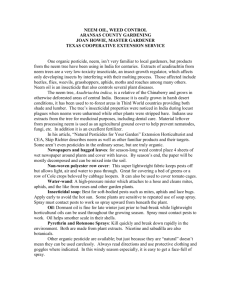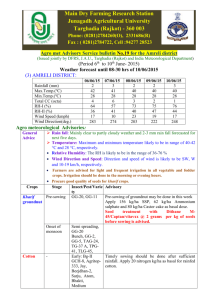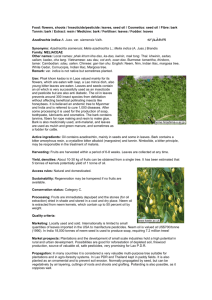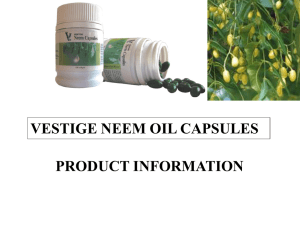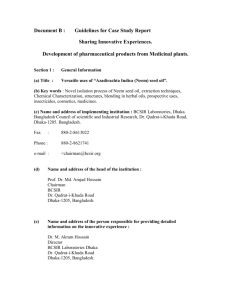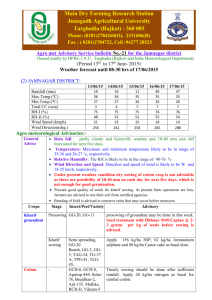antifungal properties of neem - E-International Scientific Research
advertisement
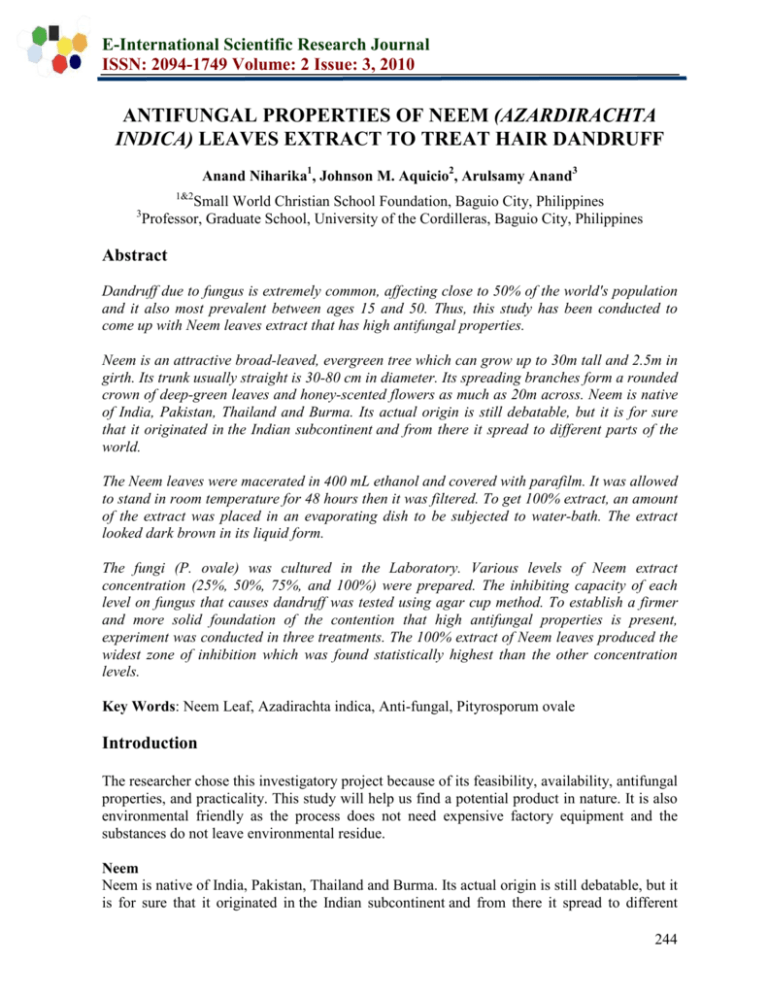
E-International Scientific Research Journal ISSN: 2094-1749 Volume: 2 Issue: 3, 2010 ANTIFUNGAL PROPERTIES OF NEEM (AZARDIRACHTA INDICA) LEAVES EXTRACT TO TREAT HAIR DANDRUFF Anand Niharika1, Johnson M. Aquicio2, Arulsamy Anand3 1&2 3 Small World Christian School Foundation, Baguio City, Philippines Professor, Graduate School, University of the Cordilleras, Baguio City, Philippines Abstract Dandruff due to fungus is extremely common, affecting close to 50% of the world's population and it also most prevalent between ages 15 and 50. Thus, this study has been conducted to come up with Neem leaves extract that has high antifungal properties. Neem is an attractive broad-leaved, evergreen tree which can grow up to 30m tall and 2.5m in girth. Its trunk usually straight is 30-80 cm in diameter. Its spreading branches form a rounded crown of deep-green leaves and honey-scented flowers as much as 20m across. Neem is native of India, Pakistan, Thailand and Burma. Its actual origin is still debatable, but it is for sure that it originated in the Indian subcontinent and from there it spread to different parts of the world. The Neem leaves were macerated in 400 mL ethanol and covered with parafilm. It was allowed to stand in room temperature for 48 hours then it was filtered. To get 100% extract, an amount of the extract was placed in an evaporating dish to be subjected to water-bath. The extract looked dark brown in its liquid form. The fungi (P. ovale) was cultured in the Laboratory. Various levels of Neem extract concentration (25%, 50%, 75%, and 100%) were prepared. The inhibiting capacity of each level on fungus that causes dandruff was tested using agar cup method. To establish a firmer and more solid foundation of the contention that high antifungal properties is present, experiment was conducted in three treatments. The 100% extract of Neem leaves produced the widest zone of inhibition which was found statistically highest than the other concentration levels. Key Words: Neem Leaf, Azadirachta indica, Anti-fungal, Pityrosporum ovale Introduction The researcher chose this investigatory project because of its feasibility, availability, antifungal properties, and practicality. This study will help us find a potential product in nature. It is also environmental friendly as the process does not need expensive factory equipment and the substances do not leave environmental residue. Neem Neem is native of India, Pakistan, Thailand and Burma. Its actual origin is still debatable, but it is for sure that it originated in the Indian subcontinent and from there it spread to different 244 E-International Scientific Research Journal ISSN: 2094-1749 Volume: 2 Issue: 3, 2010 parts of the world. As Neem is considered in India as a very important part of the household and is very much respected for its medicinal value, it spread with the migration of people. It is said that when people from India were taken as slave to the Fiji islands, with them they took the seeds, kernels of Neem. As Neem can grow in various temperatures, it flourished in tropical and warmer climates of Fiji and from there is spread to the south Pacific islands. Now Neem is cultivated in central and south America, West Indies and Australia. (Refer AppendixI) Neem or Margosa is a botanical cousin of mahogany. It belongs to the family Meliaceae. The Latinized name of Neem - Azadirachta indica - is derived from the Persian: Azad = Free, dirakht = Tree, i - Hind = of Indian Origin This literally means: ‘The Free Tree of India’ Neem is an attractive broad-leaved, evergreen tree which can grow up to 30m tall and 2.5m in girth. Its trunk usually straight is 30-80 cm in diameter. Its spreading branches form a rounded crown of deep-green leaves and honey-scented flowers as much as 20m across. This amazing tree has been a help to human race since 4,500 years ago. One of the immediately perceivable impact of this antifungal, antibacterial and, perhaps, even antiviral king of the arboretums on the human body is its guaranteed ability to heal or cure many, if not all, skin diseases or epidermal problems ranging from dandruff, acne, psoriasis, ringworm, athlete’s foot, warts, chicken pox, small pox and malaria. Further, Neem produces painrelieving, anti-inflammatory and fever-reducing compounds that can aid in the healing of cuts, burns, sprains, earaches, headaches, as well as fevers, possibly dengue. On the other hand, Neem tree encompasses the treatment of a variety of physical ailments such as heart disease, diabetes, blood disorders, digestive and nervous disorders, parasites and, possibly, cancer. Moreover, Neem may also be used as spermicidal as well as mouthwash. Dandruff Scalp skin is unique on the body due to the density of hair follicles and high rate of sebum production. These features make it susceptible to superficial mycotic conditions (dandruff, seborrheic dermatitis, and tinea capitis), parasitic infestation (epiclesis capitis), and inflammatory conditions (psoriasis). These scalp conditions share similar clinical manifestations of scaling, inflammation, hair loss, and pruritus. Causes of Dandruff Internal causes of dandruff: 1. Hormonal imbalance 2. Allergic Hypersensitive 3. Lack of rest and fatigue 245 E-International Scientific Research Journal ISSN: 2094-1749 Volume: 2 Issue: 3, 2010 4. Improper nutrition and intake of fried foods and aerated drinks, fats, sugars, salts, chocolates, sea food, Peanuts and lastly dairy products 5. Stress, anxiety and tension. External causes of dandruff 1. Frequent use of hair sprays and gels 2. Use of mousse, hairspray and instruments such as heated hair straighteners 3. Infrequent shampooing of the hair or inadequate rinsing of the scalp can cause dandruff problems. 4. Cold weather and dry indoor heating. 5. Tight fitting hats and scarves. 6. Extreme weather, oily skin and use of lotions that contain alcohol may increase the chances of dandruff Main Cause of Dandruff The cause of dandruff is usually a fungus called Pityrosporum ovale (P.ovale) which is a naturally occurring yeast-like organism found on the scalp and other parts of human skin. The fungus is found most on skin areas with plenty of sebaceous glands: on the scalp, face and upper part of the body and gradually P.ovale fungus tends to concentrate on the scalp where a large number of sebaceous glands can be found. These are the glands that produce your skin's natural oil, called sebum, which contributes to the growth of the P. ovale fungus. As the fungus grows in size and numbers, it results in dandruff. Statement of the Problem with Hypotheses This research aims to answer the following queries: a) Does Neem leaves extract have antifungal properties? b) Does Neem leaves extract have high antifungal properties? Significance of the Study Why use Neem? The common treatment for the dandruff is antifungal and anti-inflammatory. a) The antifungal is treated with antifungal drugs. To treat the antifungal, the drug has to be specifically designed to treat the fungi. However the fungal and human cells are similar at the molecular level. This makes it more difficult to find or design drugs that target fungi without 246 E-International Scientific Research Journal ISSN: 2094-1749 Volume: 2 Issue: 3, 2010 affecting human cells. Consequently, many antifungal drugs cause side-effects. Some of these side-effects can be life-threatening if the drugs are not used properly. b) The anti inflammatory is treated with cortisone which belongs to group of steroids. Excessive use of cortisone will help reduce excess inflammation however it may cause damage to the spine. Neem produces antifungal, antibacterial, pain-relieving, and anti- compounds that would treat dandruff. Methodology Antifungal Extraction from Neem Leaves Cut a hand full of semi-dry Neem leaves in to small pieces. Macerate the leaves in 400ml ethanol and cover it with Parafilm. Let it stand in room temperature for 48 hours. Filter it. To get 100% extract, place an amount of the extract in an evaporating dish to be subjected to water-bath. Determining High Antifungal Properties of Neem Leaves Extract The fungi (P. ovale) were cultured in the Laboratory. Various levels of Neem extract concentration (25%, 50%, 75%, and 100%) were prepared. The inhibiting capacity of each level on fungus that causes dandruff was tested using agar cup method. To establish a firmer and more solid foundation of the contention that high antifungal properties is present, experiment was conducted in three treatments: Results and Discussion Determining High Antifungal Properties of Neem Leaves Extract Antimicrobial Susceptibility Test with Neem Leaves Extract Table 1: Zone of Inhibition of the organism from dandruff as affected by Neem leaves using agar disc method Sample Concentration 100% 75% 50% 25% 1 15mm 10mm 10mm 7mm Replication 2 18mm 11mm 9mm 6mm 3 19mm 13mm 9mm 7mm The results show that 50% and above level of concentration has optimal level of inhibition on the dandruff growth. The higher the concentration, the higher is the inhibition on the growth of dandruff. The various measurement seen in the table refers to the zone of inhibition (diameter) 247 E-International Scientific Research Journal ISSN: 2094-1749 Volume: 2 Issue: 3, 2010 in millimeters. The extract is said to be effective if the zone of inhibition is 10 mm and above. The fungus is susceptible to the Neem leaves extract. Table 2: Statistical Analysis of the Effect of Neem Leaves Extract Concentration of Neem Leaves Extract (%) 100% 75% 50% 25% Mean of the Zone of Inhibition (mm) 17.33 a 11.33 b 9.33 bc 6.67 c Means with the same letters are not significantly different, (Bonferroni, 5%). Presented in Table 2 are the zones of inhibition produced by the different concentration of Neem extract. The 100% extract of Neem leaves produced the widest zone of inhibition which was found statistically highest than the other concentration levels. The sample treated with 75% Neem extract showed the second widest zone of inhibition (11.33 mm) but was found at par with the 50% concentration, which produced about 9.33 mm zone of inhibition. The sample treated with the lowest concentration of 25% extract produced the smallest diameter of 6.67 mm, which was found not significantly different from the 50% extract. Thus, the sample treated with 100% extract was the most effective. Summary, Conclusion, and Recommendation Even though Neem tree has been existing for more than 4500 years and known for its medicinal properties, there are hardly any studies conducted in Philippines to understand its uses in treatment of dandruff. This study is one of its kinds in Philippines. The main objective of this research is to determine its high antifungal property, which is less harmful to the normal cells. Secondly, the study intends to prove that Neem leaves extracts can inhibit the growth of P. ovale fungus, which is the main cause of dandruff. Summary of the Findings The study aimed to determine whether antifungal extracts can be taken out from Neem leaves and if this contains high antifungal properties. Based from the observations and results, the following were the salient findings of the study: The 100% extract of Neem leaves produced the widest zone of inhibition which was found statistically highest than the other concentration levels. Conclusions The following conclusions were drawn based from the findings of the study: 1. Antifungal extracts can be taken from Neem leaves extracts. 2. Neem leaves extracts have high antifungal content. 248 E-International Scientific Research Journal ISSN: 2094-1749 Volume: 2 Issue: 3, 2010 Recommendations Based from the findings and conclusions of the research, further studies must be conducted to validate the statements: Since Neem leaves extracts have high antifungal content, it can turned into antidandruff shampoo. Further experiments could be done to understand the effect of the Neem leaves extract on human beings. There could also be a study to find out how much does the Neem leaves extracts affect the normal cells when used as antidandruff shampoo. 249 E-International Scientific Research Journal ISSN: 2094-1749 Volume: 2 Issue: 3, 2010 References Amelia C. Bulmer1 and Glenn S. Bulmer1 The antifungal action of dandruff shampoos, Mycopathologia, Volume 147, Number 2 / August, 1999, 63-65 Boekhout T, Kamp M, Gueho E. Molecular typing of Malassezia species with PFGE and RAPD.Med Mycol 1998;36:365-72. Boni E. Elewski, 2005, Clinical Diagnosis of Common Scalp Disorders, J Investig Dermatol Symp Proc 10:190 –193, Gueho E, Boekhout T, Ashbee HR, Guillot J, Van Belkum A,Faergemann J. The role of Malassezia species in the ecology of human skin and as pathogens.Med Mycol 1998;36:220-9 Gueho E, Leclerc MC, de Hoog GS, Dupont B. Molecular taxonomy and epidemiology of Blastomyces and Histoplasma species. Mycoses 1997;40:69-81. Gueho E, Midgley G, Guillot J. The genus Malassezia with description of four new species. Antonie Van Leeuwenhoek 1996;69:337-55. Hay RJ, Graham-Brown RA.Dandruff and seborrhoeic dermatitis: causes and management. Clin Exp Dermatol 1997;22:3-6. Leyden JJ,McGinley KJ, Kligman AM. Role of microorganisms in dandruff. Arch Dermatol 1976;112:333-8. Malassez, L. Note sur le champignon du pityriasis simple. Arch Physiologie 1874;1:451. Robert Baran, Howard I. Maibach., 2005 Text book of cosmetic dermatology Taylor and Francis Publishers, p 259. Pierard-Franchimont C,Hermanns JF,Degreef H, Pierard G.From axioms to new insights into dandruff. Dermatology 2000;200:93-8. Shuster S.The aetiology of dandruff and the mode of action of therapeutic agents. Dermatol 1984;111:235-42. Br J Saint-Leger D, Kligman AM, Stoudemayer TJ. The role of resident microflora in the pathogenesis of dandruff. J Soc Cosmet Chem 1989;40:109-17. http://www.discoverneem.com/neem-tree.html http://www.nature.com/jidsp/journal/v10/n3/full/5640201a.html http://www.innvista.com/health/herbs/castorop.htm http://www.stuartxchange.org/TanganTangan.html http://www.crescentbloom.com/ 250 E-International Scientific Research Journal ISSN: 2094-1749 Volume: 2 Issue: 3, 2010 APPENDIX- I NEEM TREE NEEM LEAVES, FRUIT & STEM NEEM LEAVES AND FRUITS 251 E-International Scientific Research Journal ISSN: 2094-1749 Volume: 2 Issue: 3, 2010 APPENDIX- II Zone of inhibition of the unknown organism from Dandruff as affected by Neem leaves using agar disc method 100% Sample Concentration –Showing 18 To 19 Mm Inhibition on the Growth of the Dandruff 75% Sample Concentration –Showing 11 To 13mm Inhibition on the Growth of the Dandruff 252
